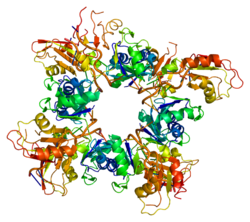PABPC1
PABPC1(poly(A) binding protein cytoplasmic 1)もしくはPABP1は、ヒトではPABPC1遺伝子にコードされるタンパク質である[5]。PABPC1はmRNAに結合し、核内外への輸送、分解、翻訳、安定性などさまざまな機能を促進する。ポリ(A)結合タンパク質には主に核内に位置するもの(PABPN1)と細胞質に位置するもの(PABPC、単にPABPと呼ぶときにはこちらを指すことが多い)が存在し、PABPC1は後者に属する。PABPC1はその位置によって、役割やRNAとの機能が変化する[6]。
機能[編集]
ポリ(A)結合タンパク質(PABまたはPABP)は真核生物のmRNAの3'末端のポリ(A)テールに複合体を形成しており、ポリ(A)鎖の伸長と翻訳の終結に必要なタンパク質である。PABPC1はPABPファミリーの一部を構成している[7]。
PABPC1は通常は細胞質内に拡散して存在しており、ストレス顆粒、P-body、翻訳活性の高い部位など、mRNAが高濃度で存在する部位に濃縮されている。PABPC1はNMDとも関係している。PABPC1はポリ(A)テールやeIF4Gと相互作用し、環状化したmRNAを安定化している。この構造はNMDを介したmRNA分解を防ぐために必要である[8]。
PABPC1は核内ではpre-mRNAのポリ(A)テールに結合し、安定性、核外搬出、輸送、分解を促進している。PABPC1は4つのRNA認識モチーフ(RRM)を持つ。最初の2つ(RRM1とRRM2)は、α-インポーチンと、プロセシングされたmRNAの双方に結合する。この結合は、mRNAが核内へ送り返されることを防いでいる[6]。
相互作用[編集]
PABPC1は次に挙げる因子と相互作用することが示されている。
出典[編集]
- ^ a b c GRCh38: Ensembl release 89: ENSG00000070756 - Ensembl, May 2017
- ^ a b c GRCm38: Ensembl release 89: ENSMUSG00000022283 - Ensembl, May 2017
- ^ Human PubMed Reference:
- ^ Mouse PubMed Reference:
- ^ “Human mRNA polyadenylate binding protein: evolutionary conservation of a nucleic acid binding motif”. Nucleic Acids Research 15 (12): 4771–87. (June 1987). doi:10.1093/nar/15.12.4771. PMC 305917. PMID 2885805.
- ^ a b “Poly(A)-binding proteins and mRNA localization: who rules the roost?” (英語). Biochemical Society Transactions 43 (6): 1277–84. (December 2015). doi:10.1042/BST20150171. PMID 26614673.
- ^ “Entrez Gene: PABPC1 poly(A) binding protein, cytoplasmic 1”. 2023年5月5日閲覧。
- ^ “The interaction of cytoplasmic poly(A)-binding protein with eukaryotic initiation factor 4G suppresses nonsense-mediated mRNA decay” (英語). RNA 20 (10): 1579–92. (October 2014). doi:10.1261/rna.044933.114. PMC 4174440. PMID 25147240.
- ^ “The Apc5 subunit of the anaphase-promoting complex/cyclosome interacts with poly(A) binding protein and represses internal ribosome entry site-mediated translation”. Molecular and Cellular Biology 24 (9): 3577–87. (May 2004). doi:10.1128/mcb.24.9.3577-3587.2004. PMC 387753. PMID 15082755.
- ^ “Mechanism of mRNA deadenylation: evidence for a molecular interplay between translation termination factor eRF3 and mRNA deadenylases”. Genes & Development 21 (23): 3135–48. (December 2007). doi:10.1101/gad.1597707. PMC 2081979. PMID 18056425.
- ^ a b “A newly identified N-terminal amino acid sequence of human eIF4G binds poly(A)-binding protein and functions in poly(A)-dependent translation”. The EMBO Journal 17 (24): 7480–9. (December 1998). doi:10.1093/emboj/17.24.7480. PMC 1171091. PMID 9857202.
- ^ “The eukaryotic polypeptide chain releasing factor (eRF3/GSPT) carrying the translation termination signal to the 3'-Poly(A) tail of mRNA. Direct association of erf3/GSPT with polyadenylate-binding protein”. The Journal of Biological Chemistry 274 (24): 16677–80. (June 1999). doi:10.1074/jbc.274.24.16677. PMID 10358005.
- ^ “Paip1 interacts with poly(A) binding protein through two independent binding motifs”. Molecular and Cellular Biology 22 (11): 3769–82. (June 2002). doi:10.1128/mcb.22.11.3769-3782.2002. PMC 133836. PMID 11997512.
- ^ “Interaction of polyadenylate-binding protein with the eIF4G homologue PAIP enhances translation”. Nature 392 (6675): 520–3. (April 1998). Bibcode: 1998Natur.392..520C. doi:10.1038/33198. PMID 9548260.
- ^ “Dual interactions of the translational repressor Paip2 with poly(A) binding protein”. Molecular and Cellular Biology 21 (15): 5200–13. (August 2001). doi:10.1128/MCB.21.15.5200-5213.2001. PMC 87244. PMID 11438674.
関連文献[編集]
- “The mRNA poly(A)-binding protein: localization, abundance, and RNA-binding specificity”. Experimental Cell Research 211 (2): 400–7. (April 1994). doi:10.1006/excr.1994.1104. PMID 7908267.
- “Human immunodeficiency virus type 1 Rev is required in vivo for binding of poly(A)-binding protein to Rev-dependent RNAs”. Journal of Virology 68 (9): 5433–8. (September 1994). doi:10.1128/jvi.68.9.5433-5438.1994. PMC 236943. PMID 8057425.
- “Role of polyadenylation in nucleocytoplasmic transport of mRNA”. Molecular and Cellular Biology 16 (4): 1534–42. (April 1996). doi:10.1128/mcb.16.4.1534. PMC 231138. PMID 8657127.
- “Interaction of polyadenylate-binding protein with the eIF4G homologue PAIP enhances translation”. Nature 392 (6675): 520–3. (April 1998). Bibcode: 1998Natur.392..520C. doi:10.1038/33198. PMID 9548260.
- “The human poly(A)-binding protein 1 shuttles between the nucleus and the cytoplasm”. The Journal of Biological Chemistry 273 (21): 13015–21. (May 1998). doi:10.1074/jbc.273.21.13015. PMID 9582337.
- “A newly identified N-terminal amino acid sequence of human eIF4G binds poly(A)-binding protein and functions in poly(A)-dependent translation”. The EMBO Journal 17 (24): 7480–9. (December 1998). doi:10.1093/emboj/17.24.7480. PMC 1171091. PMID 9857202.
- “The expression of poly(A)-binding protein gene is translationally regulated in a growth-dependent fashion through a 5'-terminal oligopyrimidine tract motif”. The Journal of Biological Chemistry 274 (3): 1708–14. (January 1999). doi:10.1074/jbc.274.3.1708. PMID 9880551.
- “Control of mRNA decay by heat shock-ubiquitin-proteasome pathway”. Science 284 (5413): 499–502. (April 1999). Bibcode: 1999Sci...284..499L. doi:10.1126/science.284.5413.499. PMID 10205060.
- “The eukaryotic polypeptide chain releasing factor (eRF3/GSPT) carrying the translation termination signal to the 3'-Poly(A) tail of mRNA. Direct association of erf3/GSPT with polyadenylate-binding protein”. The Journal of Biological Chemistry 274 (24): 16677–80. (June 1999). doi:10.1074/jbc.274.24.16677. PMID 10358005.
- “Recognition of polyadenylate RNA by the poly(A)-binding protein”. Cell 98 (6): 835–45. (September 1999). doi:10.1016/S0092-8674(00)81517-2. PMID 10499800.
- “Chromosomal localization of three human poly(A)-binding protein genes and four related pseudogenes”. Human Genetics 105 (4): 347–53. (October 1999). doi:10.1007/s004390051113. PMC 1865476. PMID 10543404.
- “A mechanism for translationally coupled mRNA turnover: interaction between the poly(A) tail and a c-fos RNA coding determinant via a protein complex”. Cell 103 (1): 29–40. (September 2000). doi:10.1016/S0092-8674(00)00102-1. PMID 11051545.
- “Translational repression by a novel partner of human poly(A) binding protein, Paip2”. Molecular Cell 7 (1): 205–16. (January 2001). doi:10.1016/S1097-2765(01)00168-X. PMID 11172725.
- “Disruption of the interaction of mammalian protein synthesis eukaryotic initiation factor 4B with the poly(A)-binding protein by caspase- and viral protease-mediated cleavages”. The Journal of Biological Chemistry 276 (26): 23922–8. (June 2001). doi:10.1074/jbc.M100384200. PMID 11274152.
- “Human testis expresses a specific poly(A)-binding protein”. Nucleic Acids Research 29 (9): 1872–83. (May 2001). doi:10.1093/nar/29.9.1872. PMC 37253. PMID 11328870.
- “Dual interactions of the translational repressor Paip2 with poly(A) binding protein”. Molecular and Cellular Biology 21 (15): 5200–13. (August 2001). doi:10.1128/MCB.21.15.5200-5213.2001. PMC 87244. PMID 11438674.
- “Paxillin associates with poly(A)-binding protein 1 at the dense endoplasmic reticulum and the leading edge of migrating cells”. The Journal of Biological Chemistry 277 (8): 6428–37. (February 2002). doi:10.1074/jbc.M109446200. PMID 11704675.
- “PABP1 identified as an arginine methyltransferase substrate using high-density protein arrays”. EMBO Reports 3 (3): 268–73. (March 2002). doi:10.1093/embo-reports/kvf052. PMC 1084016. PMID 11850402.
- “Purification and characterization of native spliceosomes suitable for three-dimensional structural analysis”. RNA 8 (4): 426–39. (April 2002). doi:10.1017/S1355838202021088. PMC 1370266. PMID 11991638.





